FEATURE STORY
Game Changer Part III: Triumph
By David Larter
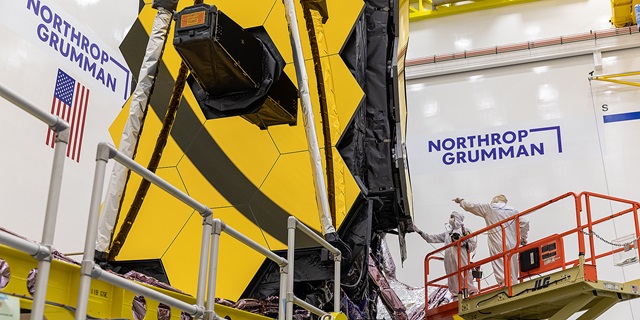
Scott Willoughby knew it was a tough blow for the team.
In the Spring of 2018, questions from the media, Congress and the science community swirled around NASA’s James Webb Space Telescope program. The headlines weren’t kind.
And, so, as Northrop Grumman’s Webb program manager, Willoughby judged he needed to address the situation with his people.
The trouble started with an environmental test on Webb’s spacecraft element (the integrated bus and sunshield) performed at Northrop Grumman’s Space Park campus in Redondo Beach, California. The test ensured Webb could withstand the intense noise of a rocket launch. While nearly everything on the spacecraft performed magnificently, technicians discovered on the ground around the spacecraft a handful of screws and related hardware that had come loose from covers used to secure the sunshield membranes inside the rocket fairing during launch.
The failure resulted from a deliberate choice by engineers to try and prevent the ends of screws protruding through their locking nuts – generally the measure that a screw is fully engaged – from snagging or tearing the fragile sunshield membranes during deployment. The failure of just a few pieces of hardware meant the whole solution needed to be reworked and redesigned. It took time and delayed Webb’s launch date. For Willoughby’s team, it was a body-blow.
“I got them together and told them: ‘I can’t tell you not to read the news,’” Willoughby recalled. “‘Read it but take it in stride. Because every single human in this room is doing something harder than has ever been attempted before.
“‘We’re going to take this and we’re going to learn, but what we know is we can’t fail on orbit. So, find your way of dealing with adversity – whatever that is – and come back and be proud. We’re going to fix it. Webb is going to work.’”
It was the rallying cry that the team needed.
The incident, while disheartening, focused NASA and Northrop Grumman on a single overriding principle: Above all else, Webb’s mission must succeed. That attitude permeated every aspect of the last years of the global effort to design and build an observatory to see the beginning of time. When all was said and done, more than 25 years after NASA leadership challenged the organization to field an large-diameter infrared telescope to replace the Hubble Space Telescope, and with thousands of challenges faced and overcome, NASA and the Northrop Grumman-led industry team achieved a triumph beyond even their highest expectations.
The hardware issue was a simple-enough fix, but any change to Webb’s staggeringly complex design took time and had to be validated. In the 15 years since the program kicked off, the NASA/Northrop Grumman team overcame numerous, seemingly insurmountable problems. But for Webb, the bar for success was as high as it could possibly be. Stationed a million miles from Earth, Webb would be beyond the kind of manned rescue mission that saved the Hubble Space Telescope when it had early technical issues. “Almost perfect” wouldn’t be good enough. It had to be flawless.
And flawless is what the team was preparing to deliver.
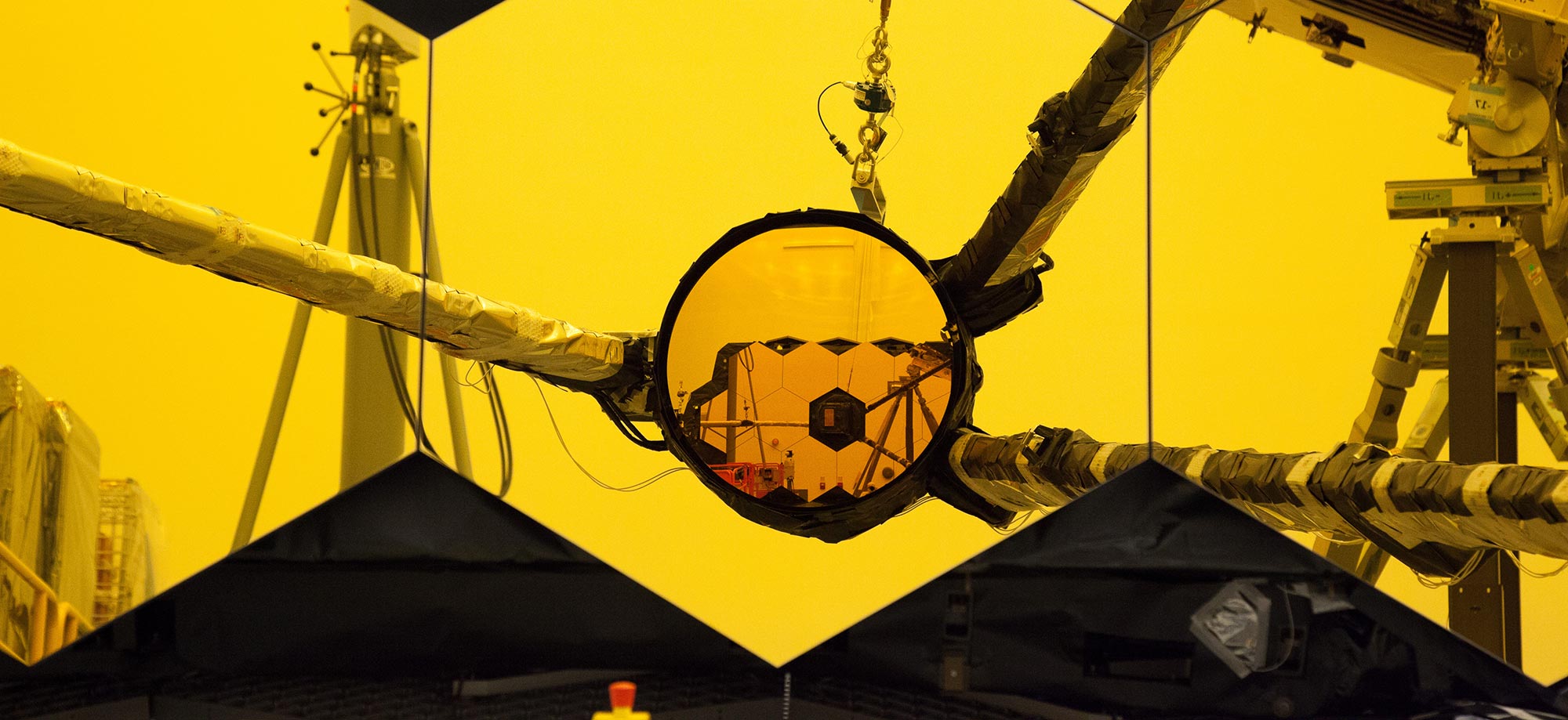
‘The most complex deployment system I’ve ever seen’
By the time Marc Roth, Northrop Grumman’s lead mechanical engineer on Webb, joined in the program in 2014, a good deal of the flight hardware and instruments were close to being ready for assembly.
NASA and Northrop Grumman were united behind the design. The key technologies that needed to be invented had been invented and proven. Major components were in final assembly and testing, from the mirrors and scientific instruments to its advanced cryocooler and the deployable tower assembly that would raise Webb’s backplane during deployment. Webb’s spacecraft bus – the part of the satellite that houses the pointing and stabilizing system, electrical power, thermal control, communications systems and more – passed its critical design review in 2014, a crucial final step toward starting to integrate the observatory.
Roth graduated from Penn State University in 1997 and moved to Los Angeles after getting a job at TRW in Redondo Beach, California, which in 2002 merged with Northrop Grumman. Roth developed a knack for working on space vehicles with deployable systems, so when he came over to the Webb program for a short-term assignment, leadership decided he should stick around.
Over his previous 17 years with Northrop Grumman, which included some very early development work with Webb, Roth had seen his share of complicated deployable space systems. But when he returned to it, he saw Webb was on another level.
“What made Webb so challenging?” Roth mused. “Well, overall, it was the most complex deployment system I’ve ever seen in my career.”
Webb was complicated because its primary mirror and sunshield were far larger than the nose cone of the rocket that would bear it to space. That meant it would need to be folded-up like origami to fit inside the rocket fairing and deploy in space. Nobody had ever tried anything quite like it at this scale. Beyond that, it needed to be light enough for the rocket to make it to orbit, and all the materials needed to be able to operate across an extreme range of temperatures without getting damaged or warped in uncontrollable ways.
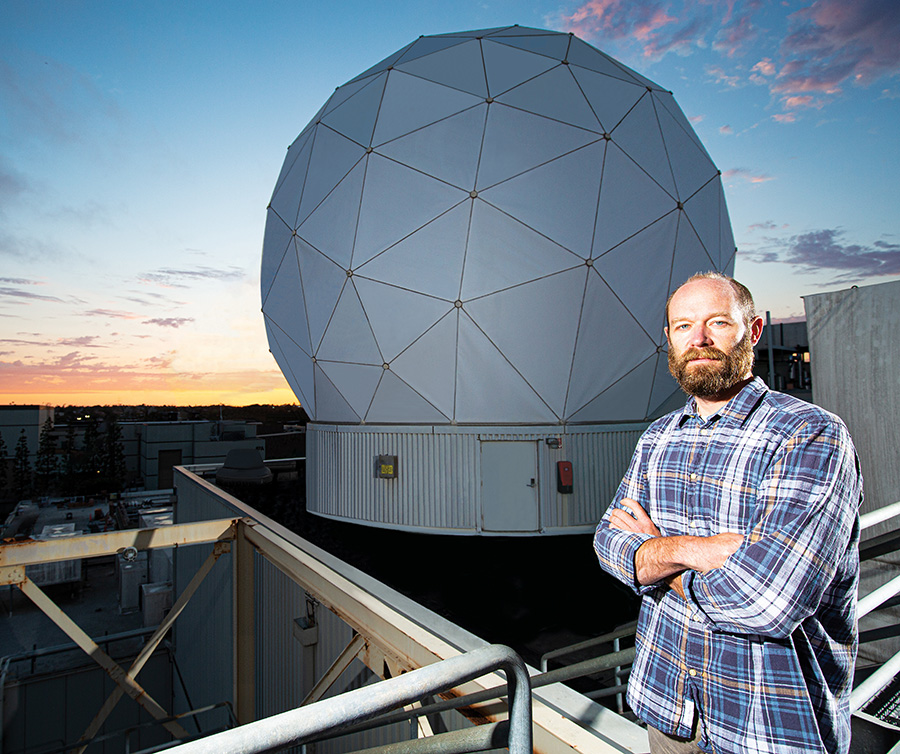
The solutions – hammered out between Northrop Grumman and NASA over years of designing, validating, testing and retesting – introduced 344 single-point failures, individual components that if they didn’t work could risk mission failure. Of those 344 single-point failures, 295 were associated with deployable systems and many of those lived in the sunshield design.
And so, as the project’s lead mechanical engineer, Roth had a lot riding on his shoulders.
The sunshield membranes were precisely designed to hold a specific shape that when deployed spanned the size of a tennis court. The membranes were constructed using a soft, coated material the thickness of a human hair that needed to remain intact through a complicated deployment sequence. A snag or tear would compromise the integrity of the design and risk the mission. A jammed pulley in the cable system, likewise, could jeopardize the mission.
The delicate sunshield needed to survive the noise and vibration of a launch without tearing itself apart, but it also needed to be stowed in such a way as to create pathways to vent any air trapped inside the sunshield membranes during the final fold. The membranes, composed of material not unlike mylar balloons, could overload the releasable tie-down points meant to keep them in place during venting. Any unintended motion of the membranes, such as billowing in the vacuum of space as operators began to deploy the sunshield, could cause a snag or tear.
Managing all that required a series of more than 100 devices, both active and passive, that could hold the sunshield in its correct shape and give operators absolute control over the deployment to avoid any snags. The active membrane release devices would fire on command from operators while passive devices (think of clips) would release after the telescoping booms on Webb’s port and starboard side pulled all five layers into shape and as operators began tensioning them.
“Managing all the forces that apply for such a complicated deployment – the timing, the loads – and making sure they were all coordinated to ensure the deployment looked as uniform as possible coming out, was a very big job,” Roth said.
“One little overload causing one of those passive devices to hold on longer than expected, or a device firing before we expected it to – any sudden release of energy – you run the risk of a snag once that energy releases. This might mean we have to push or pull harder than we want to, or not have the correct resistance controlling the deployment. It was a challenge.”
‘It was how we stowed it’
Before Roth’s intricate dance of active and passive release devices could unfold, however, the sunshield had to be stowed for launch. Webb would only get one shot to get it right, so getting the process of stowing the sunshield correctly was, in Willoughby’s mind, foundational to its success.
“You know what I think the most critical element of the whole thing was?” Willoughby asked. “What was the most important part for the success of that deployment? It was how we stowed it.”
The Webb team often compares the stowing process to parachute rigging: A lot of time and attention goes into packing a parachute, checking, and rechecking everything to make sure it will work as expected when it’s time to deploy.
The process seemed straight-forward. Sunshield manager Jim Flynn’s team along with the integration team developed the process and practiced it many times on the full-scale sunshield model. But when the Northrop Grumman team first married the flight sunshield to the flight bus to create the spacecraft element in 2014, it was clear that performing the folding and stowing on the real-live Webb was going to be tricky, said Rob Pattishall, Northrop Grumman’s director of integration and testing for Webb.
“It’s this incredibly intricate process,” Pattishall said. “There are 107 spots with these tiny holes where the membrane release devices are installed. And, of course, there are five layers that we fold, accordion-style, seven times.”
“Okay, so imagine getting all those holes lined up, right through all those layers, through seven fold lines: I mean, it’s incredibly difficult. Plus, membrane material is only a mil (1,000th of an inch) thick. Handling it is a nightmare, we are constantly dealing with small tears.”
The first time the team managed to fold the flight hardware sunshield, it took more than two months – much longer than the two weeks anticipated – and the team needed to perform three deployment tests, which meant four more folding cycles including the final fold and stow for launch.
“After that first fold, we were like ‘Wow, we need to see what happened here,’” Pattishall recalled. “So, I had the team perform a triage: What did we assume going in, what actually happened, and are there things we could do better? And, you know what we found? We found out that there were things we could do differently but that, overall, we did a pretty darn good job folding it the first time. It was just going to take the time it takes.
“So, instead of a couple of weeks of folding cycles times four, we had a couple of months times four. We had a sizeable schedule expansion just based on learning. Nobody had ever folded Webb’s sunshield before and when we did it, we learned a lot.”
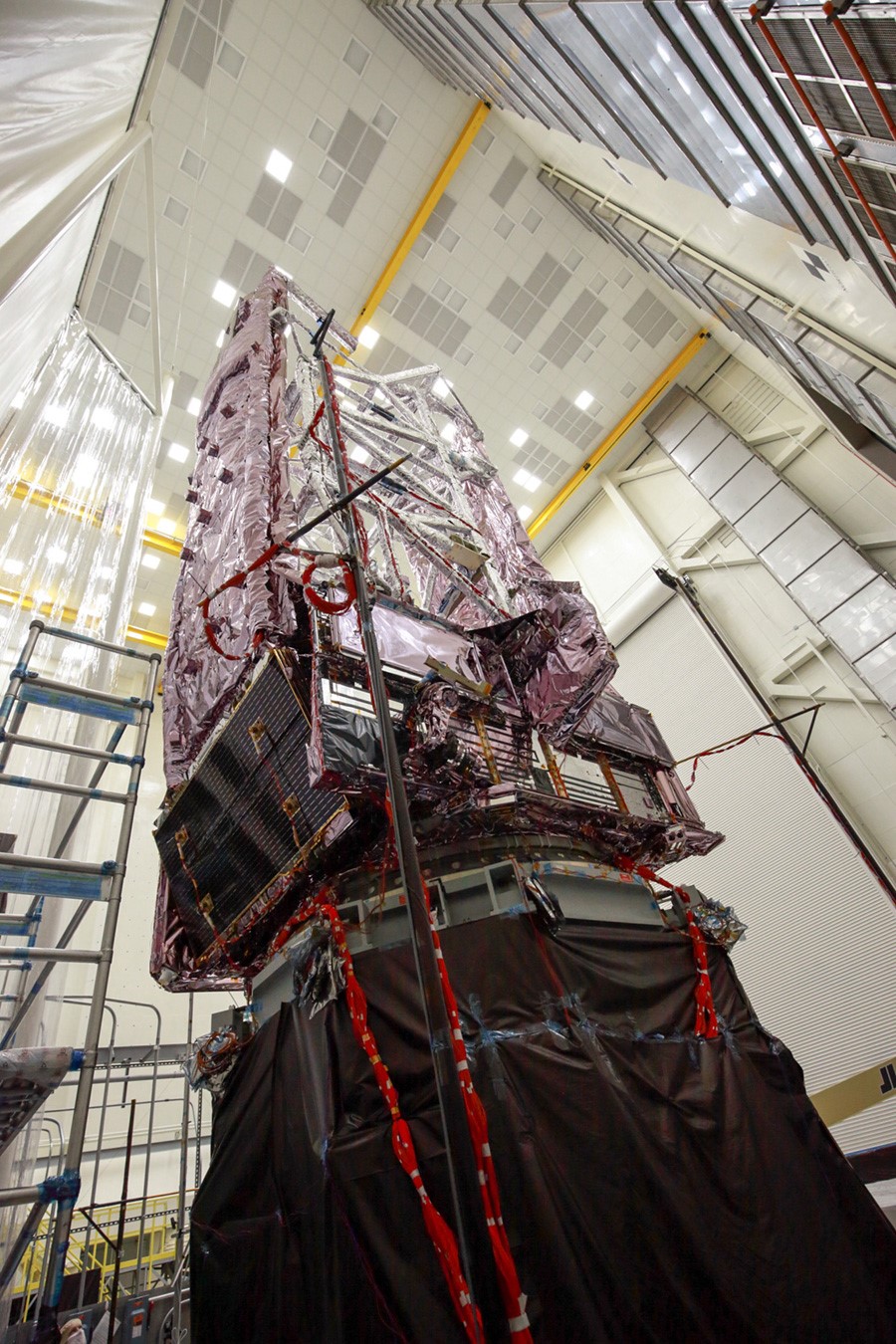
A Model Program
Both the precise ballet of Webb’s deployment sequence and the painstaking work of stowing the sunshield would have been unthinkable without relying heavily on models and mock-ups.
Northrop Grumman’s chief engineer for Webb, Charlie Atkinson, was a veteran of the Northrop Grumman-legacy Chandra X-Ray Telescope program and he would have it no other way. For most of Webb’s major components, the team developed full-scale models known as “pathfinders,” including the telescope, backplane and, critically down the stretch, the sunshield.
Webb was an entirely new design, and with mission success at front of mind, Atkinson insisted on pathfinders that could be subjected to tests simulating launch and on-orbit conditions. Additionally, the pathfinders allowed the team to work out the manufacturing and operation of the components before anyone started messing with flight hardware.
“I was adamant about doing it based upon our lessons-learned from Chandra,” Atkinson said. “Pathfinding all of the activities to go build a new telescope was incredibly important. The lessons you learn more than pay for the cost of the model and the schedule it takes to do it completely avoids schedule hits that will happen later if you don’t.”
The sunshield pathfinder – known as the Independent Verification Article (IVA) – proved invaluable as teams worked out the complicated stowing process, Pattishall recalled.
“The integration and test team, as well as the engineering team, developed the fold-and-stow process on the IVA,” Pattishall recalled. “So, when we folded it the first time and found a bunch of things that we could have done differently, when we changed something, we changed it on the IVA and then we practiced it before we moved to flight hardware.”
Roth said using models – both rapidly constructed, low fidelity models and advanced models like the IVA, was integral to working out Webb’s exquisitely timed deployment process, a process the team was still evolving even in the final months of the program.
“So, if our team found something on the vehicle that it wasn’t sure about, we would run over to the IVA and we’d simulate on the full-scale model where there was not as much of an impact if we tear something or damage something,” Roth said. “All the way up to the final build, we were making adjustments and changes and you don’t want to do that on the flight vehicle. A lot of engineering models and mock-ups were used before we ever got to integrating and implementing flight parts.”
Testing
The level of testing that went into NASA’s James Webb Space Telescope ahead of the launch was, in Roth’s words, “atypical.”
In the final years of the program, Webb’s flight hardware went through a rigorous series of tests on both the spacecraft element and the full observatory. The team followed each series of tests with a deployment test – to make sure everything still functioned – and the stowing cycle.
- Thermal Vacuum Testing: Where the spacecraft element was put into a vacuum chamber to simulate the conditions in outer space. Technicians raised the temperatures to as high as 215 degrees Fahrenheit and as low as minus 235 degrees Fahrenheit. (The fully assembled observatory never went through full thermal vacuum testing, only the spacecraft element).
- Acoustics Testing: Where first the spacecraft element then the fully assembled observatory was put in a chamber and blasted with acoustic energy to simulate the noise of a rocket launch.
- Vibration Testing: Where the first the spacecraft then the observatory was put on a shaking table and rattled it across three movement axes to make sure the intense vibrations of launch don’t break the observatory’s complex deployment architecture or instruments.
The incident with the loose hardware from the acoustics test on the spacecraft element was one of a handful of issues uncovered in testing that the Webb team needed to address. To Willoughby’s mind, however, that’s why you test in the first place.
“If the ends of the screws were protruding through the nuts, it would be a snag source,” Willoughby recalled. “Our engineers tried and failed to come up with something a little more elegant. But there were 1,000 screws and we were trying to avoid adding a thousand more components to the telescope to smooth those ends over. And of the thousand only one or two percent failed, but it had to be perfect. So, it was humbling: We tried to do something, and we learned on the ground that it didn’t work.”
In the wake of the resulting schedule delay, an independent review hammered out a workable process to limit further complications but made one thing very clear: The overriding goal was mission success. That’s something Willoughby took with him every day for the rest of the build.
“I didn’t hide the report or throw it in the garbage,” Willoughby said. “I took it with me to every meeting. And when I would get questions about why something was costing more or taking a little more time, I would hold it up and say, ‘I have one criterion.’ I wrote it on the glass window of my office. Number 1: Quality; Number 2: Technical success; Number 3: Schedule. And it’s still on there today.”
Getting Webb right required the team to work two shifts and into the weekends, and the immensity of the challenge weighed on them.
“I wore this all pretty heavily,” Pattishall recalled. “I definitely lost sleep over it. I got to the point where every day our team was working, I came to work, even if I didn’t feel like I had anything specific that I needed to do.
“Partially I felt like, if the team is here, I should be here to support them. But, also, because I wasn't relaxing at home knowing that folks were working. I wanted to know what was going on and be involved. So, at some point, that switch flipped, and it was on my mind almost 24/7. So, yeah, it was stressful.”
With each successive test, however, Webb got better and better. Using models and pathfinders to make changes every step of the way – right up to the final build phase – the Webb team came closer to producing its masterpiece.
When in late 2020 and early 2021, the team deployed Webb in its Space Park clean room for the last time prior to the final build and stow for launch, Pattishall said he could feel it coming together.
“By the time we got to that third deployment test, I felt like we weren’t fixing things anymore, we were just polishing,” Pattishall said. “We had a really minor event on that test, not something that would have impacted the overall success of the deployment. And that was a good feeling.
“Every once in a while, I would remind myself that it’s 10-times harder on the ground than it is on orbit. When you get on orbit, there’s no gravity so it’s much easier. But, of course, that was balanced against the fact that 1,000 things had to go right from this to work. So, I never got carried away.”

‘I felt the immensity’
The word Atkinson thinks about when considering the Northrop Grumman team’s final build and stowing of Webb in 2021 is “care.”
“The team on the floor had done these operations numerous times before,” Atkinson recalled, “and they knew this was the last time. They knew that it had to be right. It was awesome to see our engineering staff clamoring to be on the floor so they could be there and make sure that what they had in their heads of how Webb needed to go back together is exactly how it was implemented.
“So, at all times we had engineers on the floor just being there to answer any questions that the techs had. They could be simple questions like ‘Why is this like that?’ or ‘Hey, this doesn't look quite right to me. Is this, okay?’ We had an engineer right there who could go over, look at it, and say, ‘Yep, that's good.’
“The care and attention that went into the final stowing of the observatory, I think, was incredible.”
For the technicians and engineers on the floor, the experience of those final days was intense. Test engineer Natalie Ramirez, who worked on developing detailed plans and procedures for the sunshield’s membrane release devices, said she felt the responsibility acutely.
“During the last push, everyone was admittedly a little bit on edge,” Ramirez said. “Because we care about the work we do. We cared about the spacecraft. So many people had been working on the spacecraft for years and years, and when you think about 'This is the last time we are performing this procedure' its weighs heavily on you. For those last two years, I felt the immensity of it; I felt the finality of it.”
Willoughby, the program manager, was pleased to hear that Ramirez felt the responsibility of the moment: It’s exactly the message he tried to drive into the team.
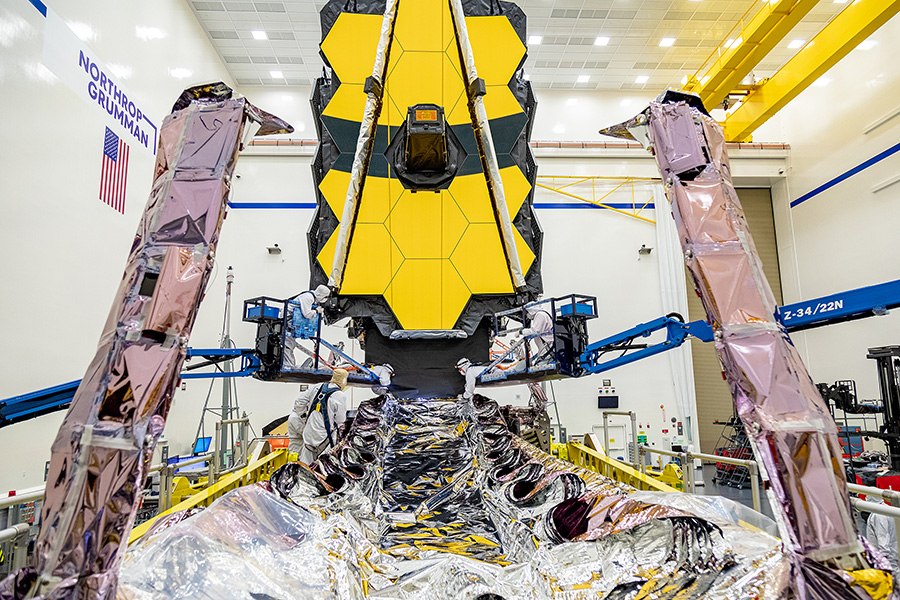
“I was very clear with the team: Everyone needs to take this personally,” Willoughby said. “You may be the last human that touches something, whether it's a piece of tape or a cable, or whether it's folding something for the last time, treat that as if you are the last human that is touching it.
“And, oh by the way, somebody’s going to be looking over your shoulder to see that you do it and to sign off on that step, and our customer is going to look at the pictures. Check your ego at the door. But be proud of what you do, and this team is going to be successful.”
In the wee hours of a late-September night in 2021, a truck arrived at Space Park to pick up some precious cargo.
After decades of dreaming, imagining, planning, and designing; after years of monumental achievements, frustrating setbacks, and an emotionally exhausting, painstaking final chapter building and stowing the spacecraft for launch, Northrop Grumman loaded NASA’s James Webb Space Telescope onto a truck.
The truck drove Webb ever-so-slowly down California’s Interstate 405 to Long Beach to meet the MN Colibri, the ship that would bear Webb to the European Space Agency’s spaceport in Kourou, French Guyana.
Webb was finally going to space.
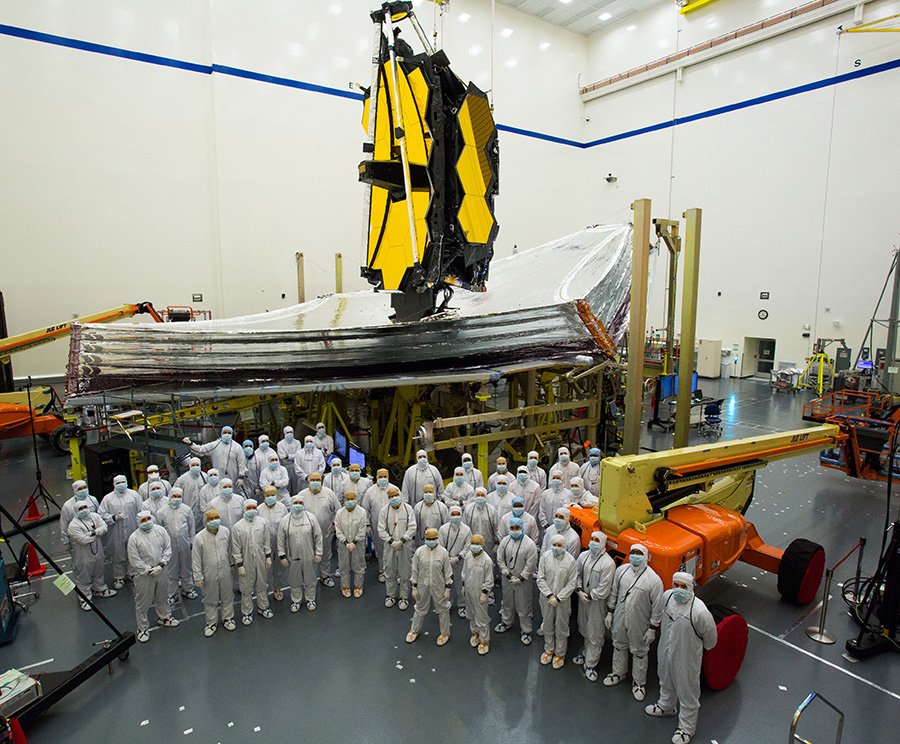
‘That’s My Team’
There were cheers and applause in mission control when the words came across the comms circuit at Webb’s mission control at Space Telescope Science Institute in Baltimore in early January: “We have a fully deployed JWST observatory.”
Two weeks earlier, on Christmas Day 2021, the European Space Agency’s Ariane 5 rocket gave Webb a perfect ride into space. Over the next two weeks, the most complex scientific tool NASA has ever put in space performed a flawless series of deployments.
The coming weeks and months would be occupied by commissioning activities – bringing Webb down to its operating temperature, aligning the mirrors, firing up the instruments and preparing for its revolutionary science mission. But for Roth, whose team gave everything they had to making Webb’s deployment a success, the moment the observatory fully deployed was one of pure joy.
“One of our mission assurance directors burst into the room where we were observing mission control and started giving us high fives,” Roth recalled. “It was just elation; we were all in that same place, just elated.”
Just days earlier, Roth had watched his intricate ballet play out on a computer display as operators deployed the sunshield. It was a moment that filled him with pride.
“We were watching the telemetry come through on the screen and I can say that it was amazingly consistent and controlled,” Roth said. “That deployment was basically the best deployment we've ever done in terms of telemetry: Every single load strap or retaining clip release, and every single piece of telemetry where we knew we would have a load spike, we saw it. It was like clockwork.”
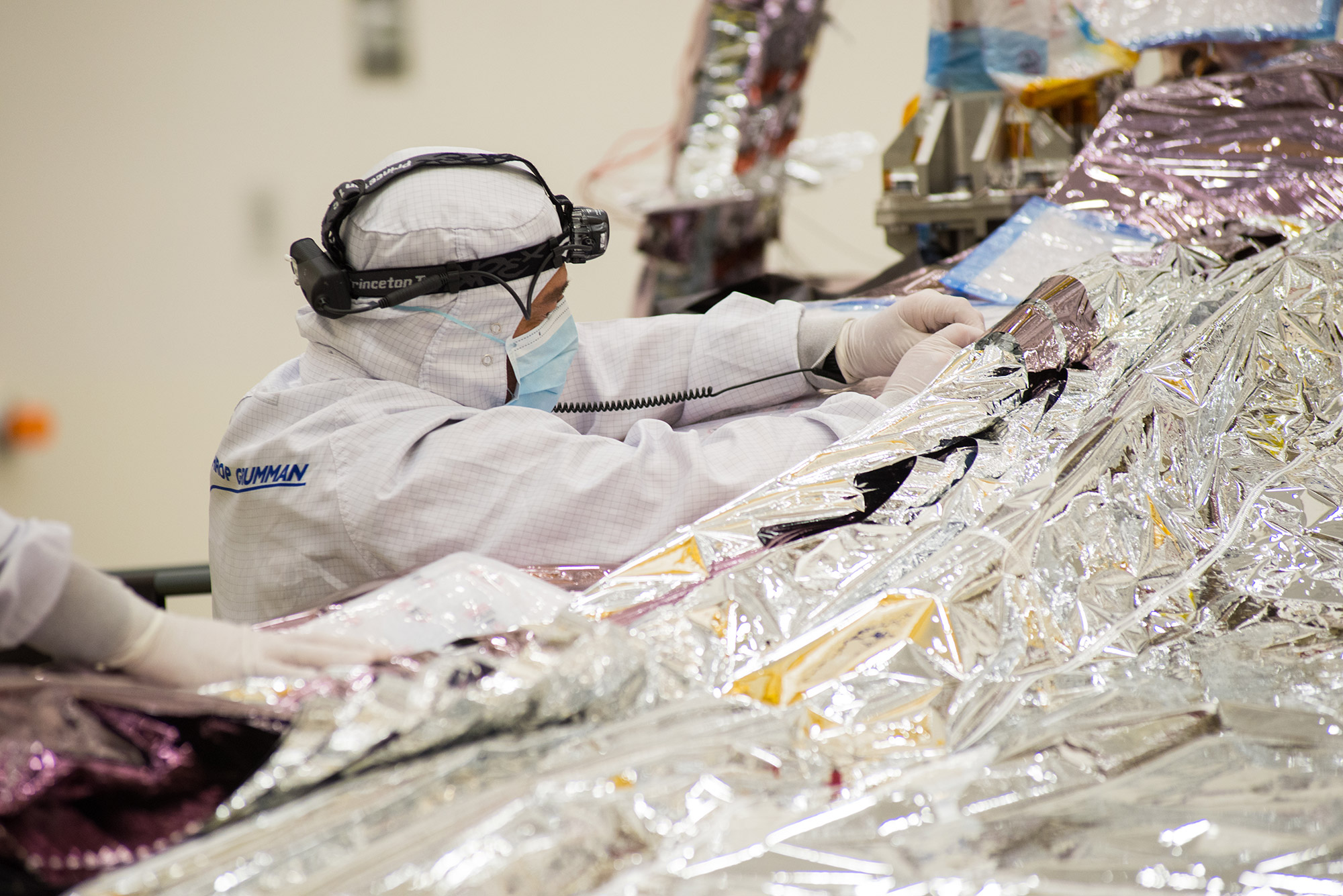
What made it special, Roth said, was seeing the happiness on his colleagues’ faces.
“So much of this program, for me, is bound up in the people,” he said. “I couldn’t have asked for a better team to accomplish what we accomplished together. Everyone had that same end goal – mission success – and that’s what got us there in the end.”
In the months after Webb’s deployment, NASA reported that Webb is performing at or above specifications across the board and, because so many things went right, Webb’s five- to 10-year science mission will likely be closer to 20 years or more
Jon Arenberg, who served as Northrop Grumman’s chief engineer for Webb through the middle part of the program, said seeing Webb perform its perfect deployment validated all the hard work so many people put in to make the mission successful.
“Up to the day before it launched, people were still saying Webb was too complicated,” Arenberg said. “People were predicting it wouldn’t work. Well, nope: sorry. It worked. All of the hundreds of people that worked on it here at Northrop Grumman, at NASA and hundreds of people across the whole industry team: Everybody did their job.”
Even in the hardest moments of the program, he never lost faith that the Northrop Grumman team would be successful, and he never saw anyone else lose faith either, Arenberg said.
“That's not in our corporate DNA, right?” he said. “I’ve never run into anybody who said, ‘Oh, wait, we can't do this. We should give up,’ and I've been here 33 years. That's the calling card of a great engineer: to believe in success, and then finding a way to get there.”
Atkinson, who had worked on the program from before it was awarded to Northrop Grumman, said that for him, the chance to work with so many teams with a common objective is the thing he cherishes most from his Webb experience.
“I'm incredibly proud of the team that made this happen,” Atkinson said. “This was not an individual effort. It was not even a collection of individual efforts. It was a collection of teams that made it possible, and to have been able to be involved with so many groups of folks, all with the same objective in mind, all with their hearts dedicated to making sure that happen: I just feel honored.”
Willoughby, the program manager who rallied his people when times were toughest, sums up his feelings in a word: Joy.
“I feel a joy with every conversation I have about Webb,” Willoughby said. “It’s a feeling I’m getting just having this conversation with you right now. And I don’t know that it will ever go away. It might change over the years, but it won’t go away.
“From now through the next 20-plus years, there’ll be press reports on some significant scientific discovery made possible by Webb. And I’m going to say: ‘That’s my team. My team built the instrument that did that. My team, together with NASA, and all our industry colleagues and suppliers – there’s credit across the board. But my team did that.’”
Editors Note: NASA estimates that more than a thousand engineers, scientists and technicians from 14 countries and in 29 U.S. states and from many different companies worked on the James Webb Space Telescope. This three-part series set out to tell the story primarily from the perspective of the dedicated employees of the industry team lead Northrop Grumman, many of whom dedicated the bulk of their careers to realizing NASA’s incredible vision. We thank all the many people who took time to help us tell this story.